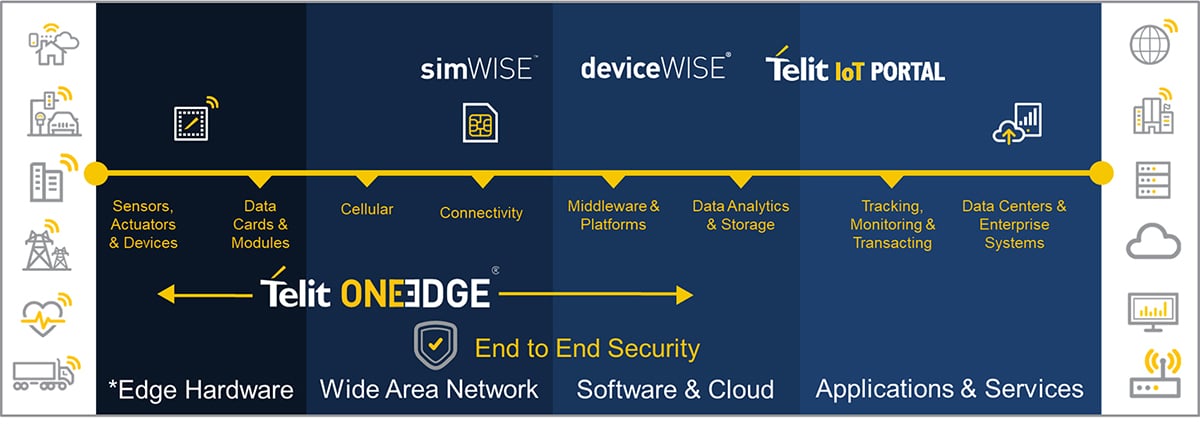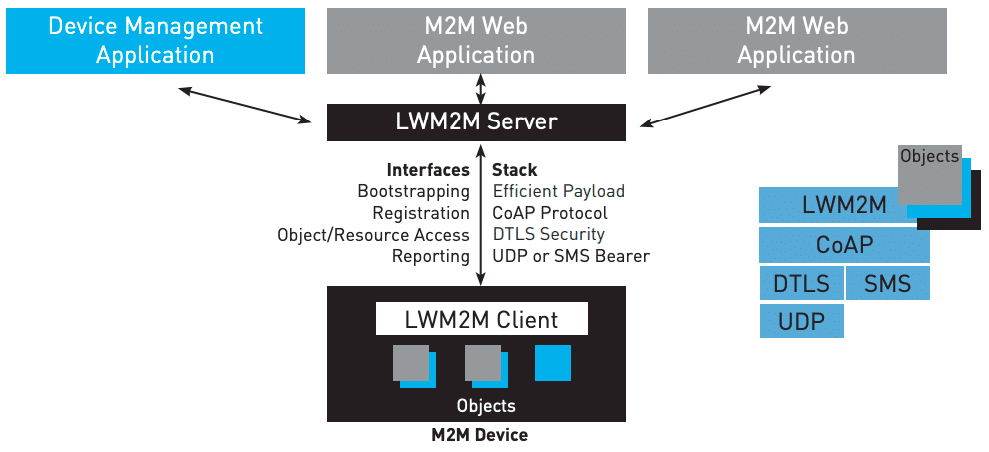Introduction
The Internet of Things (IoT) continues to mature at an impressive rate, bringing faster, less expensive capabilities into the hands of businesses and organizations to drive innovative use cases. According to a recent Orbis Research report, the IoT market is expected to achieve a CAGR of 21% from 2020 to 2025.1
One of the strengths driving this IoT surge is the dropping cost and coverage increase of low-power cellular functionality for acquiring real-time data from massive arrays of sensors and lightweight devices and transmitting it back to analytic applications to support better, faster decisions. This process starts at the network edge for IoT applications, with the devices and data they acquire and generate. Sophisticated analytics applications can use this data to make enormously valuable insights, but even the best analytics application is useless without data.
For organizations developing IoT use cases, access to network edge data is all-important. Yet some IoT platform providers undervalue its significance and capabilities, leaving a gap between the data at the edge and the applications and services that need it. In this paper, we take a closer look at what’s required to bridge this gap and how Telit solutions can help.
On the IoT Journey, the First Mile of IoT™ Is Key
We’ve all heard about the last mile in internet access, which extends the service provider’s network connection to the consumer’s home to provide connectivity. In IoT, the focus is not on the last mile but on the first. In IoT use cases, data starts from the endpoint devices at the edge of the network. It is collected, frequently secured with validation and encryption, and transmitted back from edge equipment to sophisticated cloud applications and services (see Figure 1).
This part of the IoT journey is the most important. When done right, it ensures organizations can acquire timely and reliable data in a form they can consume, adds value and drives the required business outcomes. Let’s take a closer look at the four critical stages of the First Mile of IoT.

Edge Hardware
The journey starts at the edge with hardware that includes elements like sensors and actuators in the field connected to devices with communication capabilities. These devices often include software components that enable users to add edge intelligence, automate tasks, and set up and manage secure connections to their business applications and services.
Efficiency is essential for these edge hardware components. Power, bandwidth and space are at a premium, and devices must be intelligent enough to curate, secure and transmit only actionable data precisely when and where it is needed. The edge hardware must play an active role in reducing cost, power consumption and data sent over a cellular connection to make this process as efficient as possible. In some cases, decisions can be made at the edge.
Wide-Area Network
The wide-area network is the second step in the journey. Edge hardware typically includes cellular modules that provide wireless connectivity to the business platform via the wide-area network. Maintaining consistent, secure connectivity is a top priority at this stage. Many IoT devices are mobile, or they may be placed in remote areas. They might sit inside shipping containers, reside on vehicles or be placed in agricultural areas. Keeping these different devices connected to a cellular network can present significant challenges.
Software and the Cloud
The next step of the journey is to get the data to a platform that can orchestrate it to the IoT applications that will use it. This stage includes middleware that allows organizations to structure the data at the edge for transmission to the cloud platform. This portion of the journey consists of data delivery and requires device and connectivity management.
Applications and Services
The final stage completes the data’s journey. With cloud integration and connectors, data collected by the edge hardware finishes its run to the services and sites that will use it. These include data centers, technical support, maintenance, smart city services and other locations where it can be enriched, analyzed and acted upon.
If data is targeted for analytics or cloud applications from third parties such as Amazon Web Services (AWS), Microsoft Azure or SAP HANA, the First Mile platform should offer a smooth pathway to them. Enterprise gateways can create direct paths that enable organizations to receive data from inside the IoT management platform for additional processing within their environment edge for transmission to the cloud platform. This portion of the journey consists of data delivery and requires device and connectivity management.
Optimizing Device Management with Lightweight M2M
Across all four stages of the First Mile of IoT, maximizing efficiency, security and manageability are essential. It is critical to choose a solution that employs a communications protocol optimized for the requirements of today’s wireless IoT solutions to support these capabilities.
The protocol should be fully backed by a standards organization and supported by an ecosystem that keeps it up to date and provides guidance on best practices around using the technology. This ecosystem should also support multiple vendors’ solutions to reduce the risk of lock-in and other integration issues. The Lightweight Machine-to-Machine (LwM2M) protocol from the Open Mobile Alliance is ideal for the purpose.
The LwM2M Protocol
Explicitly designed for thin edge devices like sensors and machine-to-machine environments, the LwM2M protocol provides a comprehensive yet light control plane between devices equipped with an LwM2M agent and LwM2M-enabled servers. With LwM2M embedded in remote devices, organizations in charge of managing IoT deployments can execute tasks, run diagnostics and applications, and manage their devices.
LwM2M is based on a model that helps improve interoperability in IoT use cases by adding a device management structure on top of the transport layer (see Figure 2). This structure includes ready-to-use standard objects, connectivity monitoring, remote device actions and support for firmware over-the-air (FOTA) and software over-the-air (SOTA) updates.

Most IoT use cases place a tremendous premium on energy efficiency, and LwM2M effectively minimizes the power consumption needed for device management. The protocol was engineered from the ground up to be efficient in its data consumption, making it ideal for IoT deployments that operate massive numbers of devices on low-bandwidth data plans.
Security is also essential across all phases, as it is in most network use cases. LwM2M provides a security framework defined as part of the protocol and offers a set of interfaces that enable organizations to fully define the security module. LwM2M is also highly flexible, scaling up efficiently to orchestrate for more sophisticated, high-end platforms. It’s much more than a communication protocol — it’s a set of interfaces and an object model that allows interoperability between solutions.
Telit Solutions Bridge the Gap
Early on, Telit recognized the potential of LwM2M to bring new technologies to IoT use cases. We assessed several emerging technologies to evaluate their applicability to the wide variety of use cases our customers were pursuing, and LwM2M emerged as a leader. As a result, we have incorporated LwM2M within our solutions and services. The Telit OneEdge™ suite includes deep integration of LwM2M to enable secure, easy-to-manage cellular IoT deployment.
OneEdge is a module-embedded software system with prepackaged, secure, easy-to-use deployment and management tools. We created this innovative solution to simplify the design, deployment and management of IoT products and solutions to help organizations embrace the full capabilities of 5G technology.
The OneEdge suite brings the high device density potential of the 5G world to IoT use cases. Organizations can connect to the cloud the moment they activate our pre-provisioned OneEdge modules, which have been thoroughly tested and network certified. A single pane of glass lets them manage all their devices, connectivity and application data.
Telit OneEdge offers a unique set of features and capabilities that enable organizations to close the First Mile of IoT gap.
- Edge intelligence enables organizations to define and build their edge device logic, speed deployment, and optimize behavior and resource usage. OneEdge provides the support needed to set control logic remotely and lets organizations utilize simplified cellular connection life cycle management. Is the device usage mostly fixed or mobile? (Will this device be taken with the patient in their vehicle or while they are traveling?)
- Embedded security features end-to-end protection across any device, transport and platform. Telit modules are secured, preprovisioned and personalized at the point of manufacture. ID, credentials and SIM functions are embedded in the modules’ trusted zones. All device-to-cloud communications are encrypted to help ensure end-to-end data integrity. Will there be many devices nearby that need to be connected at once (e.g., a hospital setting)?
- Connectivity service and management includes simplified connectivity management and integrated SIMs with carrier switch options for maximum deployment flexibility. How will the type of connectivity affect device aesthetics, such as antennas?
- Enterprise integration includes support for leading third-party business systems and smooth data delivery to applications.
- Centralized device management features time-savers like zero-touch onboarding and automated software updates. OneEdge also supports remote provisioning and configuration, as well as monitoring and troubleshooting capabilities.
We provide the solutions — including modules, connectivity data plans, device management, IoT software and managed services — so organizations can focus on building and designing IoT systems and applications that drive their business to the next level.
Put Telit OneEdge to the Test
Telit OneEdge addresses all the challenges of IoT’s crucial First Mile, from the edge to the IoT application. As an integrated end-to-end solution, OneEdge has the advantage of simplicity, allowing it to bring speed, cost savings and reduced risk to organizations pursuing innovative new use cases for IoT.
Endnote
1. Orbis Research, “Internet of Things (IoT) Market-Growth, Trends, and Forecast (2020-2025),” February 1, 2020.


